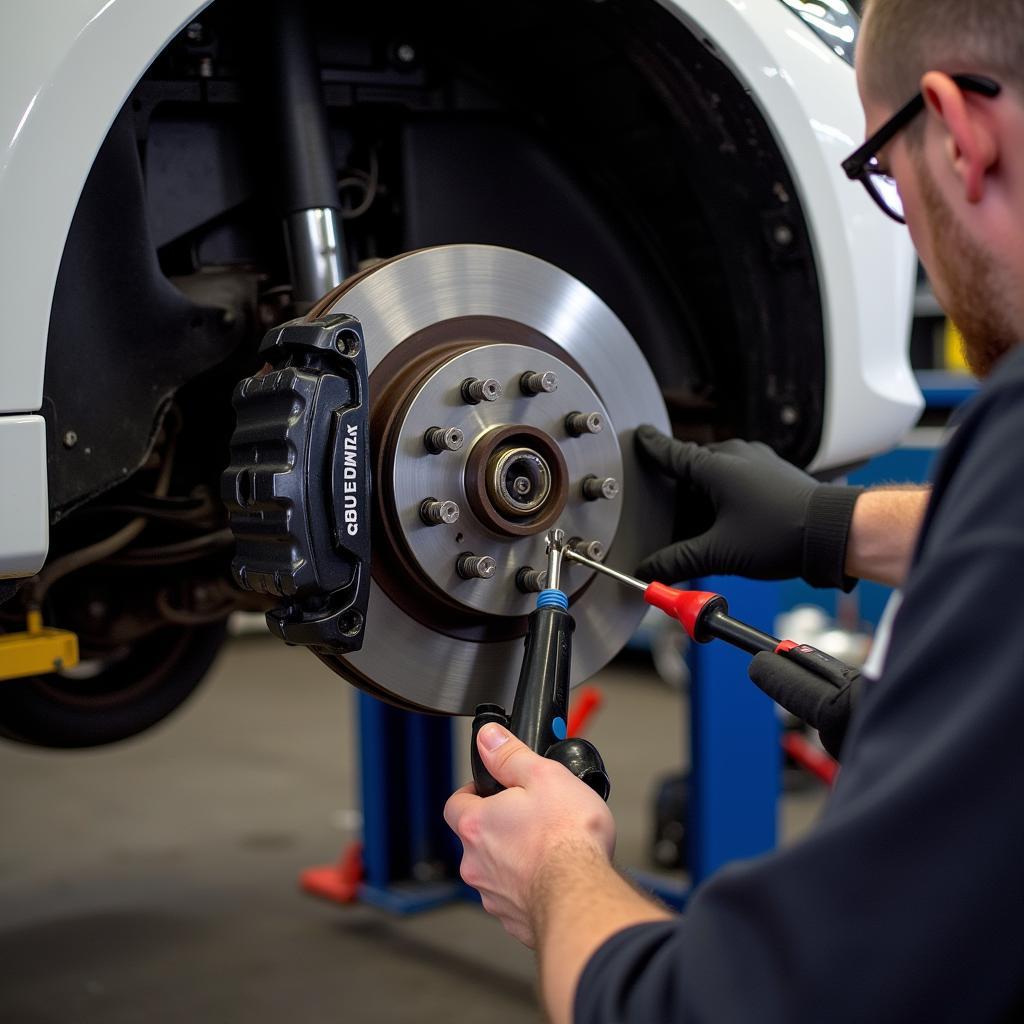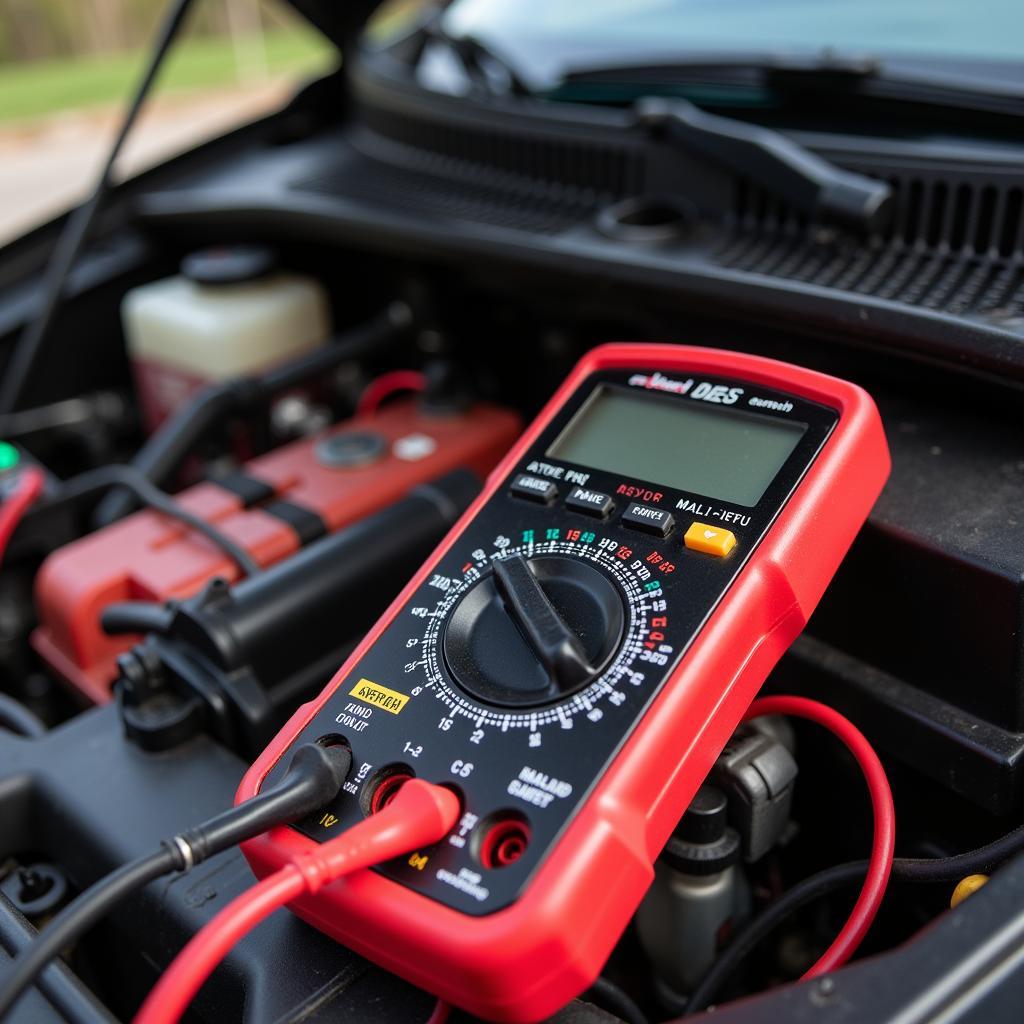A glowing brake warning light on your BMW 1 Series dashboard can be a cause for concern, but it doesn’t always signify a major problem. This guide will walk you through the common reasons behind this warning light and provide step-by-step instructions on how to reset it.
Understanding Your BMW 1 Series Brake Warning Light
Your BMW 1 Series utilizes sensors in your braking system to monitor various components and alert you to potential issues. When the brake warning light illuminates, it could indicate one or more of the following:
- Worn Brake Pads: This is the most common reason. Your BMW is equipped with brake pad wear sensors that trigger the warning light when the pads thin out and require replacement.
- Low Brake Fluid Level: Brake fluid is essential for transmitting force from your brake pedal to the wheels. A leak or low fluid level can compromise braking performance and trigger the warning light.
- Faulty Brake Sensor: In some cases, a malfunctioning brake pad wear sensor or another sensor in the braking system can cause a false warning.
- Issues with the ABS (Anti-lock Braking System): While a separate warning light usually accompanies ABS problems, there might be instances where the general brake warning light comes on.
 BMW 1 Series dashboard with brake warning light illuminated
BMW 1 Series dashboard with brake warning light illuminated
Before You Reset: Safety First
It’s crucial to remember that a glowing brake warning light should never be ignored. Before attempting any reset, prioritize your safety:
- Check Your Brake Fluid: Safely park your car on a level surface and inspect the brake fluid reservoir. If the fluid level is low, adding more won’t solve the root problem. You’ll need to address a potential leak.
- Inspect Your Brake Pads: If you’re comfortable doing so, visually examine your brake pads for wear. Look for thin pads or metal-on-metal contact, which indicates severely worn pads.
- Proceed with Caution: If you observe significantly low brake fluid or severely worn brake pads, it’s not recommended to drive the car. Contact a qualified mechanic or BMW service center immediately.
 A person checking the brake fluid level in a BMW engine bay.
A person checking the brake fluid level in a BMW engine bay.
How to Reset Your BMW 1 Series Brake Warning Light
If you’ve determined that the warning light is triggered by worn brake pads (and you’ve replaced them) or suspect a faulty sensor, you can attempt to reset the warning light. Here’s a general method that often works for BMW 1 Series models:
Important: This method might vary slightly depending on your specific model year. Refer to your owner’s manual for the most accurate instructions.
Method 1: Using the Instrument Cluster
- Turn the ignition ON: Insert your key and turn it to position one or press the Start button without pressing the brake pedal.
- Access the service menu: Use the steering wheel controls to navigate to the vehicle information or service menu on your instrument cluster display.
- Locate the brake reset option: Look for options like “Vehicle Check,” “Service Interval,” or similar. The exact wording may differ.
- Select the brake reset: Choose the option related to resetting the brake warning light.
- Follow the on-screen prompts: The system might guide you through a brief reset procedure, which could involve pressing and holding certain buttons or confirming the reset.
Method 2: Disconnecting the Battery
Warning: Disconnecting your car battery can affect various vehicle settings and electronics. Proceed with caution.
- Disconnect the negative terminal: Locate the negative (-) terminal on your car battery. Use a wrench to loosen the nut and carefully disconnect the cable.
- Wait: Wait for at least 15-20 minutes to allow the vehicle’s electrical system to discharge fully.
- Reconnect the negative terminal: Reconnect the negative battery cable and tighten the nut securely.
- Start your engine: Start your car and check if the brake warning light has been reset.
When to Seek Professional Help
If the brake warning light persists after trying these reset methods or if you’re unsure about any aspect of diagnosing or repairing your brakes, it’s crucial to seek professional help. A qualified mechanic or your BMW service center can accurately diagnose the issue, perform any necessary repairs, and ensure your braking system functions safely.
 A mechanic inspecting the brakes of a BMW 1 Series on a lift.
A mechanic inspecting the brakes of a BMW 1 Series on a lift.
FAQs About BMW 1 Series Brake Warning Light
Q: Can I drive with the brake warning light on?
A: It’s not recommended. Driving with a brake warning light can be dangerous. Have your car inspected as soon as possible to diagnose and address the underlying issue.
Q: How often should I replace my brake pads?
A: Brake pad lifespan varies depending on driving style and conditions. As a general rule, have them inspected every 10,000-12,000 miles.
Q: Can I add brake fluid myself?
A: You can top off brake fluid if the level is slightly low. However, if the level drops frequently, it indicates a leak that needs professional attention.
Q: How much does it cost to replace brake pads on a BMW 1 Series?
A: Brake pad replacement costs vary based on location and whether you choose OEM or aftermarket parts. On average, expect to pay between $150-$300 per axle.
Q: What is involved in a brake fluid flush?
A: A brake fluid flush involves removing the old fluid from the system and replacing it with fresh fluid. This service is typically recommended every 2-3 years or as specified in your BMW’s maintenance schedule.
Conclusion
Addressing the brake warning light on your BMW 1 Series promptly is essential for your safety on the road. While you can sometimes reset the light yourself after addressing minor issues, remember that professional diagnosis and repair are often necessary to ensure your braking system functions optimally. Regular maintenance, including brake inspections and fluid flushes, can go a long way in preventing unexpected brake problems.

